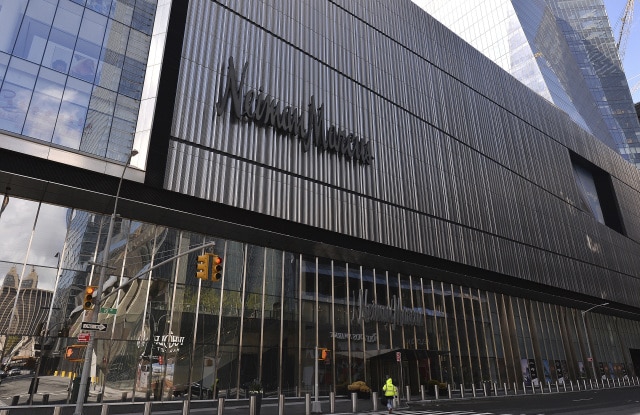Everything to Know About the Bankruptcy – WWD
The Neiman Marcus Group is just one of many major retailers being severely impacted by the coronavirus pandemic, joining the growing list of brands filing for bankruptcy.
Prior to the outbreak, there was speculation that the company, which is behind Neiman Marcus, Bergdorf Goodman, Mytheresa, Horchow and Last Call, was the next retailer to file for bankruptcy because of its $4 billion in long-term debt. The COVID-19 pandemic has created an additional struggle for the retailer, as its stores have been closed since March.
The 113-year-old retailer follows several other fashion brands that have succumbed to the pressures of the pandemic and filed for bankruptcy over the last few months, including J.C. Penney, J. Crew, Centric Brands and True Religion, among others.
Here, WWD breaks down the specifics of Neiman Marcus’ bankruptcy, including the factors that contributed to the filing and prospective buyers.
Has Neiman Marcus filed for bankruptcy?
The Neiman Marcus Group filed for Chapter 11 bankruptcy protection on May 7 at the U.S. Bankruptcy Court for the Southern District of Texas.
The company has lined up $675 million in debtor-in-possession financing and reached a restructuring support agreement with a majority of its lenders.
Are the Neiman Marcus stores closing?
The Neiman Marcus Group temporarily closed its 43 Neiman Marcus and two Bergdorf Goodman stores nationwide in compliance with guidelines set by the Centers for Disease Control and Prevention in response to the COVID-19 pandemic. It has since reopened 31 stores for customer traffic.
Court documents indicate the retailer is closing four Neiman Marcus locations, including its recently opened 188,000 square-foot location at Hudson Yards, as well as its Bellevue, Wash., Palm Beach, Fla. And Fort Lauderdale, Fla. locations. It has also closed 17 out of 22 Last Call outlets.
Sources indicate that Neiman Marcus may also close its doors in Dallas, St. Louis, Natick, Mass. and Westchester, N.Y.
In March and April, the company furloughed roughly 11,282 full-time and part-time employees, who are now being brought back in phases as the retailer reopens stores.
The retailer regained sales momentum in June when it generated $185,435,500 in sales, compared to $141,127,000 in May. Net losses in June were $56,512,000 compared to $74,728,000 in May.
In an interview with WWD, Neiman Marcus Group chief executive officer Geoffroy van Raemdonck stated the closures and layoffs were “not a workforce reduction” or a “reaction to anything happening in the economy now,” rather a strategic decision to redeploy resources.
The company is also closing two of its distribution centers in Longview and Las Colinas, Tex.
These changes fall under van Raemdonck’s four-year plan — initiated in August 2018 — to transform the Neiman Marcus Group into a “preeminent luxury customer platform.” The closures will help the company allocate more resources to its Neiman Marcus and Bergdorf Goodman divisions.
What factors contributed to Neiman Marcus’ bankruptcy?
The COVID-19 pandemic has strained the company’s operations because of its temporary store closures nationwide. The company also furloughed roughly one-third of its 13,700 employees as a result of those closures. The stores, in addition to its e-commerce sites, MyTheresa, Last Call and Horchow, generate $5 billion in annual volume.
Neiman Marcus Group has long-term debt of $4 billion and is paying roughly $300 million in annual interest expense, which is dragging down profitability and resulting in losses. It plans to eliminate its debt in the bankruptcy process.
The company also defaulted on large interest payments on bonds due on April 15, which raised the possibility of a bankruptcy filing. Neiman’s had a five-day grace period on $72.9 million in interest payment due on its bonds maturing in 2024 and a 30-day grace period for $5.7 million in interest due on bonds maturing in 2021.
Neiman Marcus has also hired the Boston Consulting Group, which assists in restructurings.
What does it mean that Neiman Marcus filed for bankruptcy?
Companies generally file for bankruptcy as a last resort after overextending their credit lines to the point where they can no longer service their debt or make lease payments. The filing gives companies the space to continue operations while formulating a plan on how to handle debt.
The bankruptcy filing halts all creditor enforcement actions against it, meaning landlords cannot evict them from their stores and mortgage lenders cannot enact foreclosure. Creditors also cannot seize the retailer’s collateral or goods.
A Chapter 11 restructuring could also wipe out debt and equity, create new ownerships and let the company close its underperforming stores, all while still operating.
What can Neiman Marcus do now that it filed for bankruptcy?
The company has several options after filing for bankruptcy. One option is to sell off parts of its business, such as its MyTheresa luxury e-commerce site or Bergdorf Goodman. Another is to work with debt holders to obtain a level of loan forgiveness or an extension on payments.
Sources indicate three other options the company may be looking at: the lenders operate the business, the business is sold to one party or the business is liquidated.
However, a liquidation seems unlikely considering that stores remain closed for the foreseeable future because of the COVID-19 pandemic.
Are there prospective buyers for the Neiman Marcus Group?
It’s been reported that Hudson’s Bay Co. chief executive officer Richard Baker has long been interested in acquiring the Neiman Marcus Group in order to combine it with Saks Fifth Avenue to create a dominant North American luxury retailer. Hudson’s Bay Company went private earlier this year.
What is the latest development in Neiman Marcus Group’s bankruptcy proceedings?
The retailer received approval of its $675 million debtor-in-possession financing package on June 16. It already obtained access to $275 million of the package at the start of the bankruptcy proceedings. The DIP funding will help the retailer reopen stores during the ongoing pandemic.
Through the proceedings, there has been dispute between the retailer and its creditors over Neiman Marcus’ handling of its Mytheresa web site in 2018.
Neiman’s unsecured creditors, who are least likely to get repaid in a bankruptcy, oppose the idea of a reorganization plan because it would release the retailer’s leveraged buyout sponsors — Ares Management Corp. and Canada Pension Plan Investment Board — from liability for claims related to the Mytheresa transaction, meaning assets would be kept away from creditors.
The unsecured creditors committee’s own reorganization proposal asks the court to allow them to be able to sue Neiman’s buyout sponsors for recoveries related to the Mytheresa transfer. The conflict will come to fuller view at the retailer’s next hearing.
Neiman Marcus plans on having a reorganization plan confirmed by early September.
How does the coronavirus pandemic impact the bankruptcy proceedings?
One impact of the COVID-19 pandemic on the bankruptcy proceedings is that the Neiman Marcus Group cannot liquidate the business while stores remain temporarily closed.
It also may be more difficult to negotiate debtor-in-possession financing to keep the business running during the pandemic.
Read more here:
How the Coronavirus Is Impacting the Fashion, Beauty and Retail Industries
Where Retailers in Bankruptcy Stand During COVID-19
WATCH: How Fashion Is Fighting the Coronavirus


